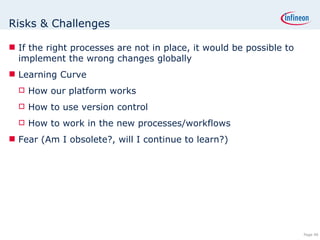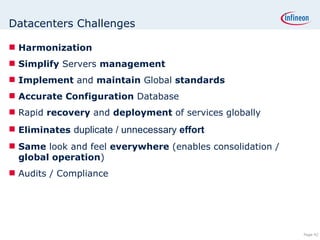A Presentation about Puppet that I've made at the OSSPAC conference
- 1. Infrastructure Automation Ohad Levy – Infineon Technologies [email_address]
- 2. Automated ”… a process which may once have been performed manually but has been altered in some way which allows a machine or computer to either wholly or partially manipulate the process to save time”
- 3. Infrastructure “ Infrastructure is generally a set of interconnected structural elements that provide the framework supporting an entire structure”
- 4. Automated Infrastructure “ Having the basic services necessary for your infrastructure to operate largely without the aid of a keeper.”
- 5. Grow – from This: http://i68.photobucket.com/albums/i2/RealConnections/googlecomputers.jpg
- 7. Where does it fit in?
- 8. Typical System Lifecycle Pre/ Installation DNS/DHCP … Initial Configuration Kickstart Jumpstart Custom Scripts Fixes Updates Audits
- 9. System configuration possibilities Manual System Configuration „ log in and „just do it!““ + OK for small number of servers + Quick and easy - Very difficult to ensure similar configurations - No auditing capability - No change history - No release documentation - No way to deploy multiple servers quickly. - No way to rebuild critical servers quickly.
- 10. System configuration possibilities Install Time Auto-Configuration „ Deploy using Kickstart, Jumpstart etc“ + Ensures that new systems are brought into proper state as part of installation process + Possible to deploy multiple servers quickly - No Validation that settings remain correct - No easy way to deploy changes - Auto-Configuration process is different between the sites leads to different configurations - No Auditing - No change history - No release documentation
- 11. Typical System Lifecycle Pre/ Installation DNS/DHCP … Initial Configuration Kickstart Jumpstart Custom Scripts Fixes Updates Audits Puppet
- 12. Puppet What is Puppet ? A product designed to deploy system configurations. It is – Open source based on Ruby Policy based Runs every 30 minutes An abstraction layer between the system administrator and the system Capable to run on any UNIX operating system
- 13. Our Challenges Keep our systems "harmonized“ Audit / Know what's going on each system Replace a server if it dies or to be able to add another server that is exactly like it Similar Applications, different OS's Push out changes to all the servers that need a particular change Stop duplicating effort Go home early
- 14. How does Puppet works?
- 15. Puppet Types A Type is a particular element that Puppet knows how to configure Files (content, permissions, ownership) Packages (installations, updates..) Services (enabled/disabled, running/stopped) Exec (run commands) Full List: cron, exec, file, filebucket, group, host, interface, k5login, mailalias, maillist, mount, nagios*, package, service, sshkey, tidy, user, yumrepo, zone
- 16. Example: Managing sudoers file file { /etc/sudoers: owner => root, group => root, mode => 600, source => puppet://server/files/sudoer }
- 17. Dependencies " require " and " before " / " after " settings ensures that types are applied in the correct order file { "/etc/sudoers": ... require => Package[sudo] } package { "sudo": ensure => present, before => File["/etc/sudoers"] }
- 18. Dependencies - continued " notify " and " subscribe " settings can trigger cascaded updates Particularly useful in services, exec file { "/etc/ssh/sshd_conf": ... notify => Service["sshd"] } service { "sshd": subscribe => File["/etc/ssh/sshd_conf“] }
- 19. What is Facter? Facter gathers information about the client, which can be used as variables within puppet. You can add custom facts as needed. package {"sshd": ensure => installed, name => $operatingsystem ? { solaris => "IFKLssh", default => “openssh-server” } }
- 20. Example Facts $ sudo facter architecture => amd64 domain => sin.infineon.com facterversion => 1.3.8 fqdn => sinn1636.sin.infineon.com hardwaremodel => x86_64 hostname => sinn1636 ipaddress => 172.20.89.113 kernel => Linux kernelrelease => 2.6.24-21-generic lsbdistcodename => hardy lsbdistdescription => Ubuntu 8.04.1 lsbdistid => Ubuntu lsbdistrelease => 8.04 macaddress => 00:1c:25:14:26:ab manufacturer => LENOVO max speed => 2000 MHz maximum memory module size => 4096 MB maximum total memory size => 8192 MB memoryfree => 988.30 MB memorysize => 1.94 GB operatingsystem => Debian operatingsystemrelease => 2.6.24-21-generic processor0 => Intel(R) Core(TM)2 Duo CPU T7300 @ 2.00GHz processor1 => Intel(R) Core(TM)2 Duo CPU T7300 @ 2.00GHz processorcount => 2 productname => 6458B43 ps => ps -ef puppetversion => 0.24.5 rubysitedir => /usr/local/lib/site_ruby/1.8 rubyversion => 1.8.6 serialnumber => L3A8632 swapfree => 912.23 MB swapsize => 956.99 MB type => Notebook uniqueid => 007f0101 vendor => LENOVO
- 21. What is a Class? A named collection of type objects Can include or inherit from other classes class sudo_class { include foo_class file { "/etc/sudoers": ... } package { "sudo": ... } }
- 22. Class inheritance class afile { file { "/tmp/foo": ensure => file source => "/src/versionA" } } class another_file inherits afile { File ["/tmp/foo"] { source => "/src/versionB" } }
- 23. What is a Node ? A configuration block matching a client Can contain types, classes "default" node matches any client without a node block node "ohad.myself" { include sudo_class include other_class }
- 24. External Nodes Node definitions can be defined outside of puppet – e.g. LDAP, external script… Ideal when you have too many nodes..
- 25. Classes and definitions Classes are groups of resources. Definitions are similar to classes, but they can be instantiated multiple times with different arguments on the same node. class apache2 { define simple-vhost ( $admin = "webmaster", $aliases, $docroot) { file { "/etc/apache2/sites-available/$name": mode => "644", require => [ Package["apache2"], Service["apache2"] ], content => template ("apache/vhost.conf"), } } }
- 26. Classes and definitions - Continued node mywebserver { include apache2 apache2::simple-vhost { "test.example.com": docroot => "/var/www/test“ } apache2::simple-vhost { "debian.example.com": docroot =>"/var/www/debian“, alias => [“debiantest.example.com”,”debian”], admin => “[email protected]” } }
- 27. vhost.conf template Puppet uses Ruby's ERB template system: <VirtualHost *> ServerAdmin <%= admin %> DocumentRoot <%= docroot %> ServerName <%= name %> <% aliases.each do |al| -%> ServerAlias <%= al %> <% end -%> ErrorLog "|/usr/bin/cronolog /var/log/apache/<%= name %>/%Y-%m/error-%d" CustomLog "|/usr/bin/cronolog /var/log/apache/<%= name %>/%Y-%m/access %d" sane </VirtualHost>
- 28. Template output more /etc/apache2/sites-available/debian.example.com <VirtualHost *> ServerAdmin [email_address] DocumentRoot /var/www/debian ServerName debian.example.com ServerAlias debiantest.example.com ServerAlias debian ErrorLog |/usr/bin/cronolog /var/log/apache/debian.example.com/%Y-%m/error-%d“ CustomLog "|/usr/bin/cronolog /var/log/apache/debian.example.com/%Y-%m/access-%d“ sane </VirtualHost>
- 29. OS API - It also works the other way around: $ ralsh user levyo user { 'levyo': groups => ['tidc'], ensure => 'present', password => 'x', shell => '/bin/bash', uid => '49960', comment => 'Ohad Levy, +65 xxxx xxxx', gid => '11100', home => '/home/levyo' }
- 30. Puppet Modules Modules allow you to group both the logic and the files for an application together. Puppet automatically searches its module path to find modules. Modules can contain four types of files, each of which must be stored in a separate subdirectory: Manifests – must be stored in manifests/, and if you create manifests/init.pp then that file will be loaded if you import that moudle name directly (e.g. import “mymodule”) Templates – must be stored under templates/, put in your manifest some where template(“mymodule/mytemplate”) Files – stored in files/, can be accessed as: source => puppet://”mymodule”/myfile Plugins – Additional types, provides or facts
- 31. File server and File Bucket Puppet also includes a file server which you can use for transferring files from the server to the client. If you configure it, puppet can also save a backup of each file that is changed on the client to the server. The backups go in a filebucket and can be retrieved later.
- 32. Getting Started Install puppet (yum,pkg-get,…) or manually install ruby, facter and puppet Setup a puppet server (puppetmaster / puppet-server). Write a manifest for your node (classes etc) Start puppet master on the server Start puppetd on the client
- 33. Some more info Puppet uses SSL for all communications, therefor it includes a CA, you can automatically sign CSR or use puppetca tool to mange them. Storeconfig, option to save machine states(facts, configuration runs) and special facts (e.g. SSH keys) in a database. Reporting, puppet has a few reporting options, most common are emails with changes, RRD files, yaml files and puppetshow web interface. Puppet HA, load balancing etc
- 34. What are the benefits ? Costs Based on open source tools – No license cost Reduced Labor Reduced Cost Productivity Reproducibility, Accuracy and homogenous environment (Reduce needed knowledge to operate our environment) Allow easy ramp up of new sites and services Change Management Testing Processes, Auditing Global control over servers Harmonization Consolidation …
- 35. Conclusions We're all stuck on the hamster wheel Makes easy stuff easier, hard stuff possible Harmonize! (not just today, also in the future) Enable the business for consolidation Similar projects cfengine bcfg2 Additional Resources http://reductivelabs.com/trac/puppet http://reductivelabs.com/trac/puppet/wiki/LanguageTutorial http://reductivelabs.com/trac/puppet/wiki/CompleteConfiguration #puppet on irc.freenode.org
- 36. Backup Slides Additional information
- 37. Configuration DB - Terminology Module – A bundle of settings related to a single application At Infineon we use 3 types of modules: Host Type - e.g. Login Servers, Compute nodes… Service - module which is needed by other modules, e.g. ssh, x11 etc. Sites Modules - sites customizations Versioning – The ability to refer (tag) to a certain state/PiT Host Type and Service modules are associated with a version, e.g. Login Server v1.0 Site Modules are not tagged in order to reduce complexity * Every change in a module, requires a check in action, which is identified by a user, and a comment (change log) * A user access restriction should be applied to each module and to the tagging mechanism
- 38. Configuration DB - Terminology Environments – The ability to select a group of modules in a certain version Each site is associated with at least two environments – Production and Testing: Testing – an environment which refer to versioned modules under a test tag. Production – A selection of modules in a certain version that has already been approved for Production usage. Development environment – The state where the modules are in the latest check-in version, but are not tagged (e.g. not a testing candidate yet). Development Testing Production (Per Host Type)
- 39. Configuration DB - Terminology Global modules / owners Each owner is responsible for his module (or modules) A special attentions is required for Service module as many other modules might depend on them Site modules As Site modules are not tagged (versioned) any change in the site specific settings, will be rolled out immediately.
- 40. Risks & Challenges If the right processes are not in place, it would be possible to implement the wrong changes globally Learning Curve How our platform works How to use version control How to work in the new processes/workflows Fear (Am I obsolete?, will I continue to learn?)
- 41. Why Did we choose Puppet Open source More flexible than other open source alternatives Really works (Declarative language, Abstracts configuration as resources, Allows relationships, Transactional, Modular) Provides an API to the OS, making it very simple to support other OS’s in the future Puppet is now being adopted in many projects For more info see http://reductivelabs.com/trac/puppet/wiki/CfengineVsPuppet http://reductivelabs.com/trac/puppet/wiki/WhosUsingPuppet
- 42. Datacenters Challenges Harmonization Simplify Servers management Implement and maintain Global standards Accurate Configuration Database Rapid recovery and deployment of services globally Eliminates duplicate / unnecessary effort Same look and feel everywhere (enables consolidation / global operation ) Audits / Compliance
- 43. Infineon Puppet Infrastructure Puppeteer (Puppet Master of site PM’s) Puppet Master per site (or based on size/load) SQL Database for Web portal, Inventory Configuration database (Version control & Ticketing system)
- 44. Gini’s Features AD/LDAP Authentication DHCP/DNS Connectors (API, + MS(yacks) DHCP, MS(yacks) DNS and infoblox) Puppet Host type management Disk Layout Management Host Hardware management (needed for Solaris DHCP jumpstart, and general host info) Multi OS management (e.g. RH, CentOs, Solaris.... in their various versions) User role management (who is allowed to install, in which site, which host type etc) Subnet and IP Management (auto assignment of IP address, DHCP reservation DNS records etc) Multi Domain / site management Hands-free auto OS installation (currently Kickstart and Jumpstart (sparc) using DHCP) Management of Puppet Environments, choose an env per host (e.g. we have different production states for different sites, or for different host types). Management of puppet certificates (also support chained certificates). Import of Machine Facts (we cant use store config due to the large setup of our env) Nice Graphs (with Gruff) Puppet modules selection per host(for those who needs more than the default host type) SP (Service Processor, iLOM etc) management TFTP management Status indications for machine state (pre installation, during puppet first run, etc) ... and probably a lot of other small stuff that I cant think of now
- 45. Our Solution Web Portal Puppet Configuration DB Inventory DHCP/DNS .. Harmonized
- 46. Where does GINI live? GINI DB DNS TFTP CERTIFICATES CMDB DHCP LOGS LSF Future work
Editor's Notes
- #9: So, how do we do handle this process today At first, we need to input the server details in a few different locations (CMDB, DHCP, DNS etc)
- #12: So, how do we do handle this process today At first, we need to input the server details in a few different locations (CMDB, DHCP, DNS etc)
- #43: Some sites have a very optimized process, Effort involved Time, new hardware, downtimes, patching/updating, installation of new services (global rollouts….) TESTING Today, there is no easy way for a global team to push changes – e.g. clearcase team needs to ask each operation team to implement the changes “auditing” is a manual process – no transparency On a global scale, we don’t really know the configuration of each site SOX etc
- #47: Database is currently centralized. Performance issues? DNS – A, PTR, CNAME, TXT. DHCP – BOOT host, file, Vendor classes of sparc. Replaces RARP and bootparams LOGS – Updates the Gini DB with live data LSF – Opens and closes hosts during the build TFTP – manipulates the boot link based upon the host status CERTIFICATES – cleans old certificates and allows autosign CMDB – Updates the CMDB with live data
![Infrastructure Automation Ohad Levy – Infineon Technologies [email_address]](https://image.slidesharecdn.com/osspac-090802232212-phpapp01/85/A-Presentation-about-Puppet-that-I-ve-made-at-the-OSSPAC-conference-1-320.jpg)








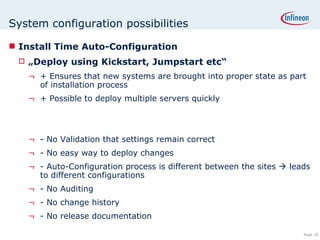



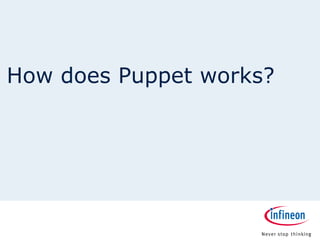

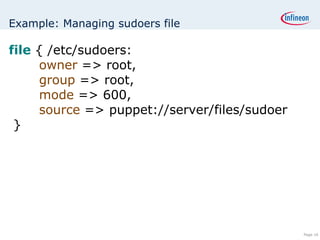
![Dependencies " require " and " before " / " after " settings ensures that types are applied in the correct order file { "/etc/sudoers": ... require => Package[sudo] } package { "sudo": ensure => present, before => File["/etc/sudoers"] }](https://image.slidesharecdn.com/osspac-090802232212-phpapp01/85/A-Presentation-about-Puppet-that-I-ve-made-at-the-OSSPAC-conference-17-320.jpg)
![Dependencies - continued " notify " and " subscribe " settings can trigger cascaded updates Particularly useful in services, exec file { "/etc/ssh/sshd_conf": ... notify => Service["sshd"] } service { "sshd": subscribe => File["/etc/ssh/sshd_conf“] }](https://image.slidesharecdn.com/osspac-090802232212-phpapp01/85/A-Presentation-about-Puppet-that-I-ve-made-at-the-OSSPAC-conference-18-320.jpg)



![Class inheritance class afile { file { "/tmp/foo": ensure => file source => "/src/versionA" } } class another_file inherits afile { File ["/tmp/foo"] { source => "/src/versionB" } }](https://image.slidesharecdn.com/osspac-090802232212-phpapp01/85/A-Presentation-about-Puppet-that-I-ve-made-at-the-OSSPAC-conference-22-320.jpg)


![Classes and definitions Classes are groups of resources. Definitions are similar to classes, but they can be instantiated multiple times with different arguments on the same node. class apache2 { define simple-vhost ( $admin = "webmaster", $aliases, $docroot) { file { "/etc/apache2/sites-available/$name": mode => "644", require => [ Package["apache2"], Service["apache2"] ], content => template ("apache/vhost.conf"), } } }](https://image.slidesharecdn.com/osspac-090802232212-phpapp01/85/A-Presentation-about-Puppet-that-I-ve-made-at-the-OSSPAC-conference-25-320.jpg)
![Classes and definitions - Continued node mywebserver { include apache2 apache2::simple-vhost { "test.example.com": docroot => "/var/www/test“ } apache2::simple-vhost { "debian.example.com": docroot =>"/var/www/debian“, alias => [“debiantest.example.com”,”debian”], admin => “system@example.com” } }](https://image.slidesharecdn.com/osspac-090802232212-phpapp01/85/A-Presentation-about-Puppet-that-I-ve-made-at-the-OSSPAC-conference-26-320.jpg)
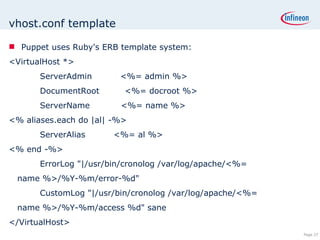
![Template output more /etc/apache2/sites-available/debian.example.com <VirtualHost *> ServerAdmin [email_address] DocumentRoot /var/www/debian ServerName debian.example.com ServerAlias debiantest.example.com ServerAlias debian ErrorLog |/usr/bin/cronolog /var/log/apache/debian.example.com/%Y-%m/error-%d“ CustomLog "|/usr/bin/cronolog /var/log/apache/debian.example.com/%Y-%m/access-%d“ sane </VirtualHost>](https://image.slidesharecdn.com/osspac-090802232212-phpapp01/85/A-Presentation-about-Puppet-that-I-ve-made-at-the-OSSPAC-conference-28-320.jpg)
![OS API - It also works the other way around: $ ralsh user levyo user { 'levyo': groups => ['tidc'], ensure => 'present', password => 'x', shell => '/bin/bash', uid => '49960', comment => 'Ohad Levy, +65 xxxx xxxx', gid => '11100', home => '/home/levyo' }](https://image.slidesharecdn.com/osspac-090802232212-phpapp01/85/A-Presentation-about-Puppet-that-I-ve-made-at-the-OSSPAC-conference-29-320.jpg)










